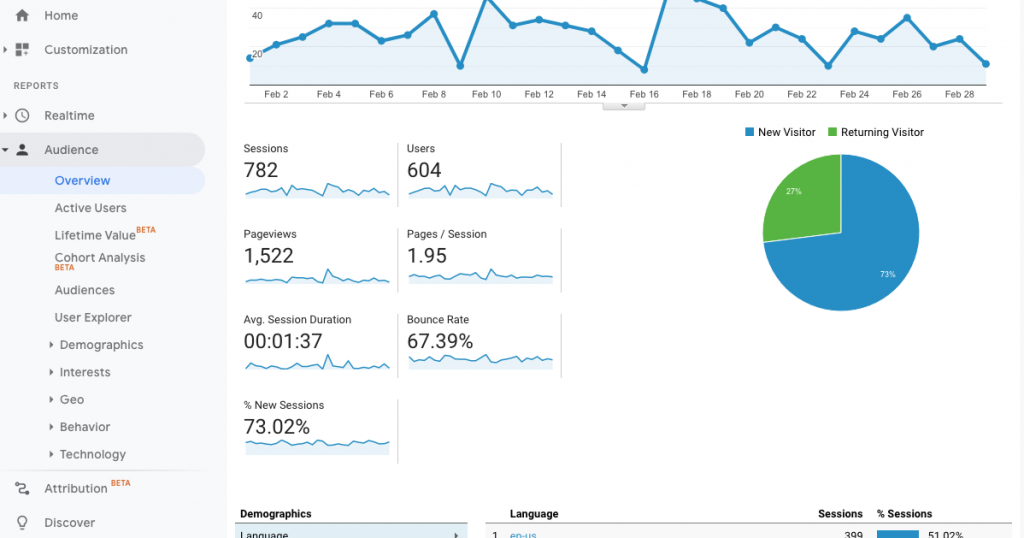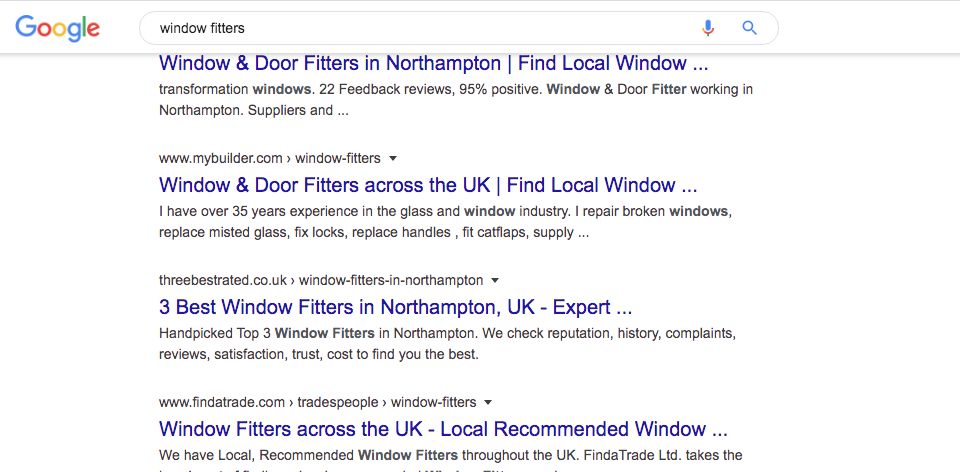What Are the Different Types of Website Traffic?
What is Website Traffic?
Website traffic refers to the volume of users that travel to a given website. Just as car traffic travels along the M6, or pedestrian traffic swarms the christmas markets, website traffic measures the digital movement of website users.
It’s important to be aware of the amount of traffic your website attracts for a number of reasons. For example, if you’ve invested heavily in a slick, state of the art website, you’ll want to ensure a significant return in the form of online traffic. Similarly, being aware of your web traffic can give you a good indication of how you’re performing in the online world.
We can use Google Analytics to easily locate our website traffic over any given period. Simply choose the period you would like to view at the top right of the screen, navigate to the ‘Audience’ tab and click ‘Overview’. You’ll see a range of data, but today, we’re concerned with ‘sessions’.


Being aware of the volumes of website traffic is one thing, but you shouldn’t stop there. By getting to grips with the types of website traffic you’re experiencing, you can enhance your understanding of your customers, better plan digital marketing strategies and know exactly where users are coming from.
We’re going to explore four types of website traffic today:
- Direct traffic
- Referral traffic
- Organic traffic
- Social traffic
Before delving into each of these in more detail, let us quickly show you how to see a breakdown of this traffic on Google Analytics. On the right-hand side, simply click the ‘Acquisition’ tab and then ‘Overview’. You’ll be greeted with a table that breaks down each type of website traffic.


Now that’s covered, let’s have a look at each type of traffic in a bit more detail.
Direct Traffic
As the name suggests, direct traffic refers to the users who travel directly to your website, without taking a journey through a search engine. Generally, direct traffic measures the users who type a URL directly into the browser or have a bookmark for the website saved.
For the majority of websites, direct traffic will consist of returning users and customers. After all, a user will have probably visited your website beforehand if they know the URL. In many cases, all returning users will need to do is simply type in the first few characters of a URL and they’ll be able to take use of the browser’s autofill feature.
There might be a few rare cases when new users account for a portion of direct traffic. Clicking a link through a word processor or spreadsheet, for example, will be counted as direct traffic.
How Can I Improve My Direct Traffic?
There’s no shortcut or definitive method to use when it comes to improving direct traffic. For users to keep returning to your website, you’ll need a website crafted with the user-experience in mind. Getting great direct traffic extends to every part of your business, from the quality of the services and products you offer, the relationships with your customers, brand exposure and much, much more.
Ultimately, the better service you provide, the more people you’ll have returning to do business with you. The latter equates to direct traffic.
Referral Traffic
You guessed it – referral traffic is when users are directed to your website through external links. By external, we mean any links that aren’t internal (from your own website) or come from Google itself. Referral traffic can be extremely valuable as it shows Google that people are taking the time to link to your content. It suggests users see benefits to your website, so much so that they want to share it with others.
You may, for example, be a company that provides window fittings. As part of your content marketing strategy, you have a blog that features a post about bay window designs. A user stumbles across your blog post while researching for their own blog, finding your expertly written piece infinitely valuable and decides to credit your post with a link. Whenever a user clicks the link from the researchers website, you’ll be credited with some referral traffic.
External links from reputable sources will give your website a tonne of online authority and inform Google that your website is trustworthy. Google rewards trustworthy websites with increased rankings!
How Can I Increase Referral Traffic?
There are a number of ways you can encourage referrals to your site:
- Offer solid, informative, high-quality content that users find value in and want to share
- Increase your online activity on social media and forums to create a network of potential links
- Similar to the above, take time to leave comments on blogs or other pieces of content
- Explore the avenue of influencer marketing
Boosting referral traffic really comes down to two things; creating fantastic content and making that content well-known.
Social Traffic
As one might expect (for the third time), social traffic is characterised by the users that take the social media route to your website. Links from Facebook, Twitter, LinkedIn, Pinterest, Instagram and more account for this kind of traffic.
Each time a user clicks a link you’ve embedded into a post, image or tweet, your website will be credited with some social traffic. Understanding how much social traffic your website is getting is great knowledge to have alongside the data you’re provided from each respective platform’s analytic tools.
When you harness the full power of social media, it’s possible to get a tonne of extra exposure, and, by extension, traffic to your site. It’s a route definitely worth exploring; click here to find out how we could help you.
How Can I Improve Social Traffic?
Specific tactics for increasing social traffic will depend on which platform you’re using. Our first piece of advice would be to get set up on every conceivable platform, and take steps to ensure that your brand is consistent across each one.
We’re not going to go into each specific platform today, but as a general rule of thumb you should always:
- Embed the most relevant piece of content to your post.
- Offer a tease or call to action; anything to encourage users to click through.
- Consider creating some content that you want to go viral if you’re planning to share it on social media. We’ve got a great blog on that subject over here.
- Monitor which posts have the most engagement (likes, shares, comments) to create content you know users want.
- Experiment posting at different times of day and on different days of the week.
Organic Traffic
Perhaps it’s harder to work out exactly what this type of traffic is just from the title, or perhaps it isn’t. Organic traffic refers to the number of users that reach your website through a SERP (search engine results page) that don’t click on a paid advertisement.
Let’s get back to basics for a moment. When a user types in a query on Google, they’ll be provided with millions of links that Google thinks will be relevant to their search. Unless specified to be an Ad, all of these links will be organic search results. When one of these links is clicked, the website it belongs to will be credited with a session from organic traffic.


Organic traffic is the single most important type of traffic to strive for. Not only will it likely account for the majority of your total traffic, but ranking well organically will give you significantly more traffic potential then any of the types we’ve mentioned so far.
Furthermore, organic traffic takes care of itself. When you put the time into ranking organically, you don’t then need to spend countless hours building links or sharing posts on social media. Traffic comes smoothly and consistently.
How Can I Improve Organic Traffic?
While it’s true that millions of links will likely appear for any given query, in the vast majority of cases, only those links on page 1 of the SERP will get a click. Therefore, if you’re serious about improving organic traffic, it’s imperative that your online presence is properly developed for SEO.
Proper keyword research, properly optimised websites and a well thought out digitally marketing strategy are all vital ingredients for a traffic boosting tonic. That’s where we come in. We, after all, dedicate our lives to elevating our clients to the top of the SERPs.
Here at Active Internet Marketing, we take the time to understand our clients’ needs and goals, ensuring a strategy that’s guaranteed to succeed. If you’d like to find out how we can boost your organic traffic results, speak to one of our friendly team on 01604 765 796. Alternatively, fill in a contact form and someone will be with you very soon!
